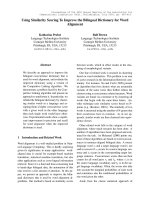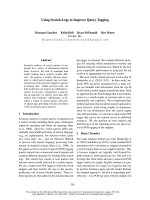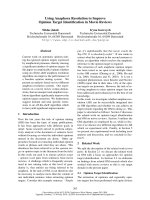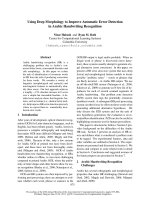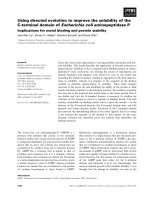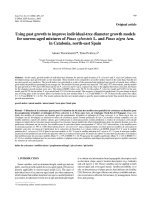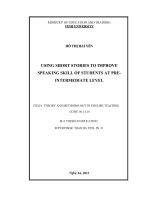Using graphic organizers to improve 10th graders’ paragraph writing
Bạn đang xem bản rút gọn của tài liệu. Xem và tải ngay bản đầy đủ của tài liệu tại đây (1.1 MB, 87 trang )
MINISTRY OF EDUCATION AND TRAINING
VINH UNIVERSITY
HÀ ANH TUẤN
USING GRAPHIC ORGANIZERS TO IMPROVE 10TH GRADERS’
PARAGRAPH WRITING
MASTER THESIS IN EDUCATION
NGHE AN - 2018
MINISTRY OF EDUCATION AND TRAINING
VINH UNIVERSITY
HÀ ANH TUẤN
USING GRAPHIC ORGANIZERS TO IMPROVE 10TH GRADERS’
PARAGRAPH WRITING
Major: Teaching English to Speakers of Other Languages (TESOL)
Code: 8.140.111
MASTER THESIS IN EDUCATION
SUPERVISOR: NGUYỄN GIA VIỆT, Ph.D.
NGHE AN – 2018
STATEMENT OF AUTHORSHIP
I certify that no other person‘s work (published or unpublished) has been
used without due acknowledgement in the main text of the thesis.
It was written by me under my supervisor‘s guidance.
Date submitted: July 2018
Student
Supervisor
Ha Anh Tuan
Nguyen Gia Viet, PhD
i
ACKNOWLEDGEMENTS
My assignment would not have been completed without the valuable
assistance and encouragement of many people for whom I am grateful including my
teacher, my family and my friends.
Firstly, I would like to thank my supervisor Dr. Nguyen Gia Viet
who
supported my work in this way and helped me a lot with assistance, support in
overcoming numerous obstacles I have been facing through my research.
Secondly, to complete this thesis, I cannot forget the support and
th
encouragement from 10 grade students at Vu Quang upper secondary school or
their cooperation and support in collecting data for this paper.
Then, I wish to send my gratitude and thank to my friends, my classmates, as
well as my colleagues from whom I have received whole hearted help and support.
I would like to thank my family for supporting me spiritually throughout
writing this thesis and my my life in general. These people deserve all the credit. I
highly appreciate all these support and contribution.
ii
ABSTRACT
This research examines the use of graphic organizes in enhancing the quality
and the effectiveness in paragraph writing among the 10th graders at Vu Quang
upper secondary school. Specifically, it dealt with the extent to which graphic
organizers help improve writing score in the process of paragraph production. The
study will employ an experimental approach to collect the data and analysis.
Students will be assigned pre-tests and post-tests to establish the quality and
effectiveness. In addition, questionnaires will be distributed to
participating
students to explore their attitudes to the use of graphic organizers in English
classrooms. Based on the results, pedagogical implications and suggestions
regarding using graphic organizers in teaching writing skill will be proposed.
From the results of this research, the effectiveness of different types of graphic
organizers in teaching and learning writing skills ought to be affirmed in other
studies in the future to make sure that graphic organizers is really necessary and
they can help language teachers teach writing skill more and more effectively. The
textbooks and other writing materials should be used graphic organizers so that the
learners will have opportunity to learn English writing better and more effectively.
Teachers will be more effective in their work, and their lesson plans will yield
greater results. Therefore, the macro view of using graphic organizers, envisions
thousands of teachers imparting academic gifts to millions of students-and each of
these more prepared than previous generations to take their places of leadership in
our rapidly developing nation.
iii
TABLE OF CONTENTS
STATEMENT OF AUTHORSHIP ............................................................................. i
ACKNOWLEDGEMENTS ....................................................................................... ii
ABSTRACT .............................................................................................................. iii
TABLE OF CONTENTS .......................................................................................... iv
LIST OF TABLES AND FIGURES ......................................................................... vi
LIST OF ABBREVIATIONS .................................................................................. vii
CHAPTER 1: INTRODUCTION ...............................................................................1
1.1. Rationale for the study .........................................................................................1
1.2. Aims of the study .................................................................................................3
1.3. Research questions ...............................................................................................3
1.4. Scope of the study ................................................................................................3
1.5. The thesis outline .................................................................................................4
CHAPTER 2: LITERATURE REVIEW AND THEORETICAL BACKGROUND.6
2.1. Introduction ..........................................................................................................6
2.2. Literature Review in Brief ...................................................................................6
2.3. Effective writing teaching requirements ..............................................................7
2.4. Theoretical Background .......................................................................................8
2.4.1. Teaching English writing ..................................................................................8
2.4.1.1. Definition of writing.......................................................................................8
2.4.1.2. Some views of teaching and learning writing..............................................10
2.4.1.3. Approaches to teaching writing...................................................................12
2.4.2. Paragraph writing...........................................................................................17
2.4.2.1. Definition of paragraph...............................................................................17
2.4.2.2. Structure of a paragraph..............................................................................18
2.4.2.3. Criteria for a good paragraph......................................................................19
2.4.2.4. Common problems and their sources in paragraph writing........................20
2.4.3. Graphic organizers in writing........................................................................22
iv
2.4.3.1. Oragnization................................................................................................22
2.4.3.2. Word choice................................................................................................23
2.4.3.3. Graphic Organizers.....................................................................................23
2.5. Summary...........................................................................................................30
CHAPTER 3. METHODOLOGY ...........................................................................31
3.1. Introduction ........................................................................................................31
3.1.1 An overview of Vu Quang high school ...........................................................31
3.1.2. Research Methods ...........................................................................................32
3.2. The Context of the Study ...................................................................................33
3.2.1 The participants ................................................................................................33
3.2.2. Research Instruments ......................................................................................34
3.3. Data Collection Procedure .................................................................................36
3.4. Summary ............................................................................................................36
CHAPTER 4. FINDINGS AND DISCUSSIONS ....................................................38
4.1. Introduction ........................................................................................................38
4.2. Results of students‘ survey questionnaire A ......................................................38
4.2.1 Students‘ attitude and their difficulties in writing lessons ...............................38
4.2.2. Summary .........................................................................................................45
4.3. Findings from the Questionnaire B ....................................................................46
4.4. Students‘ attitudes toward graphic organizers ..................................................48
4.5. Results of students‘ tests ....................................................................................49
4.6. Summary ............................................................................................................53
CHAPTER 5. CONCLUSION AND IMPLICATIONS ...........................................54
5.1. Summary of the study ........................................................................................54
5.2. Implications for effective writing lessons ..........................................................56
5.3. Limitations of the study .....................................................................................60
5.4. Suggestions for further study .............................................................................60
REFRENCES ............................................................................................................62
v
LIST OF TABLES AND FIGURES
Table 4.1. Students' attitude towards the steps they usually follow ........................41
Table 4.2. Students' difficulties in writing a paragraph ............................................42
Table 4.3. Activities carried out by teachers in class ................................................43
Table 4.4. Students‘ assessment towards graphic organizers ...................................46
Table 4.5. Students' attitudes towards graphic organizers........................................48
Table 4.6. Results of students‘ tests ..........................................................................50
Table 4.7: Pre-test and post-test results by experimental group ...............................52
Figure 4.1: Opinions about the most important skill ................................................38
Figure 4.2: Students‘ enjoyment to the writing lessons ............................................39
Figure 4.3: Students‘ ideas about writing a paragraph..............................................40
Figure 4.4: Students‘ ideas the necessity of teacher‘s guidance in the English
writing lessons ...........................................................................................................44
Figure 4.5: Students‘ ideas about teacher‘s guiding and support activities ..............45
Figure 4.6: Pre-test and post-test mean scores by the control and experimental groups .51
vi
LIST OF ABBREVIATIONS
CLT
: Communicative Language Teaching
EFL
: English as Foreign Language
ESL
: English as a Second Language
L1
: First Language
L2
: Second Language
vii
CHAPTER 1: INTRODUCTION
1.1. Rationale for the study
Regarded as an international language, English plays an important role in our
modern society. Now it is used medium of communication in many aspects of life
all over the world. In Vietnam, English is a compulsory subject in the national
curriculum, it is taught in all schools in Vietnam as a foreign language.
Teaching English in Vietnam will give students a good chance to take
advantage of globalization, and teachers are always trying to renew teaching
methods to improve their techniques for more effective lesson plans and higher
cognitive retention among their students at all levels. Together with other skills such
as reading, speaking, listening the role of writing is very important.
It also has been introduced in order to keep pace with the society
development, the need for writing is put in one of the top demand for English
language.
In fact, when we learn the first language and second language writing skill is
very necessary. Furthermore, it is the ways planned and organized thought
expressions. However, writing is considered one of the most difficult skills due to
its complication and high demand of language means. In spite of the fact that there
is high awareness of the field of teaching and learning English language writing, it
seems to be a neglected area in English language teaching at upper secondary
school level in Vietnam.
The main reason for this
negligence owing to the fact that most
examinations in English in Vietnam only test the students‘ knowledge
about
grammar and referenced standard. In addition, students even some teachers do not
spend much time and efforts on teaching and learning writing leads to Vietnamese
high school students‘ dissatisfying results in their writing.
1
These low outcomes are because of various factors including students‘ lack
background knowledge and low capability of language. Actually, despite the fact
that numerous students are good at doing tests in basic structures, they can scarcely
write a good essay or even a paragraph. In this way, it is gainful to give some point
of view strategies for training writing keeping in mind the end goal to enhance their
written work capacities.
While accentuating the significance of writing skill, the researcher cannot be
in disregard of the importance of paragraph writing. Grabe and Kaplan (1996) ,
cited in Ha (2016) indicated to students in EFL (English as a Foreign Language)
that contexts, ranging from a simple paragraph and summary skill to the ability to
write essay is needed for the mastery of English writing skill. This is because
paragraph writing is a pre-requisite course for composition and essay writing.
Therefore, to any learner, learning how to write a good paragraph is necessary
before learning how to write any other text and it is needed to transfer messages,
letters, and knowledge, to take exams and to maintain learning.
Because of the importance noted above, English paragraph writing is
included in the syllabuses of Vietnamese high schools, in which school learners
have to pay attention to ―higher level skills of planning and organizing as well as
the lower level skills of spelling, punctuation, word choice, and so on‖ Richards and
Renandya (2002).
As well as other objective factors, the role of teachers is very important in
helping students to express their ideas successfully in their writing. In the class the
teachers‘ roles are giving suggestions and support to students to complete their
writing tasks.
As a teacher, one of the major focuses within the classroom is writing
instruction. It is the educators‘ job to help students build confidence and find
success as they begin learning about the writing process. Many students struggle
with the ability to organize their writing and also show difficulty in incorporating
creative word choice in their writing. The ultimate goal of this study was to help
2
improve these key areas in an effort to help students become more effective,
proficient writers and also enjoy the writing process.
In this study, the author indicated the use of graphic organizers, confirmed
their effectiveness in improving 10th graders paragraph writing at upper secondary
school.
This study was guided by the following questions: ―Do graphic organizers
improve students‘ writing scores?‖, ― What attitudes do students have about using
graphic organizers in paragraph writing?‖.
Graphic organizers is hoped to be used widely as an effective technique for
teaching writing in upper secondary schools in Vietnam.
1.2. Aims of the study
The study is conducted with the following aims:
- to examine students‘ attitudes towards writing skill.
- to look into the difficulties students cope with during writing paragraph.
- to evaluate the effectiveness of using graphic organizers in teaching paragraph
writing to students.
- to offer some suggestions and recommendations to enhance students‘ writing
paragraph.
1.3. Research questions
So as to achieve above mentioned aims, the study tries to answer the
following questions:
1. Do graphic organizers improve students‘ writing scores?
2. What attitudes do students have about using graphic organizers in paragraph
writing?
1.4. Scope of the study
In spite of the fact that there are numerous approaches to motivate students
to learn English, it is unrealistic to cover them all in this paper.
Owing to the limitation of time and length of the thesis, I chose to focus my
research on utilizing graphic organizers as a way of improving paragraph writing
3
for 10 grade students at Vu Quang upper secondary school. The students of control
group and experimental group are comprised of 60 students of grade 10 at this
school.
1.5. The thesis outline
In this thesis, there are five chapters:
Chapter I: Introduction
This chapter introduces the rationale, objectives , research questions, scope
and organization of the study.
Chapter II: Theoretical background
The theoretical background of previous studies related to the topic will be
described in chapter II. A review and explanation of graphic organizers is the last
part of this chapter.
Chapter III: Methodology
This chapter consists of details the research methods, research instruments,
information gathering strategy and the setting of the investigation which comprises
of the background setting and member determination. This help the readers to have
a profound comprehension in transit in which the theory of the postulation is
interpreted and explained.
The researcher utilized questionnaires for students and pre-test, present test
on gather information and to give proof to the investigation's adequacy.
The analysis of the data in this study will be a base for the researcher to give
the comments, remarks, recommendation and conclusions.
The data drawn from the student‘s questionnaires and tests were analyzed
and categorized. These findings were utilized as the foundation for my ensuing
suggestions for the application and use of graphic organizers.
Chapter IV : Finding and discussion – describes the major finding from data
analysis, obervation and disuss on the analysed results.
4
Chapter V: Conclusion
In chapter V, the summary of the contents achieved from the study will be
presented. The following parts, the researcher provides to readers the implication of
the study, the limitation of the study and the recommendation for further research.
The references and appendices are the last parts of the study and they are
followed the conclusion.
5
CHAPTER 2: LITERATURE REVIEW
AND THEORETICAL BACKGROUND
2.1. Introduction
In this chapter the author introduces two small components: literature review
in brief, and theoretical background. The first part will be a summary of the
previous related researches, the second one will be theoretical review about
teaching English writing, and using graphic organizers in paragraph writing.
2.2. Literature Review
Writing is the skill that processed by human being to produce his or her ideas
and thought into written-forms, although the ideas or thought can also produce
through spoken-forms. It means that through spoken forms will be transfer in
written forms. Therefore, writing is one of important skill can produce of human
thought in written forms.
In Brown (as cited in Emilie and Nathalie, 2007 p. 335), he stated that, a
simplistic view of writing would assume that written language is simply the graphic
representation of spoken language. This is supported and developed by Hedge, (as
cited in Emilie and Nathalie, 2007 p. 10) who states that ―writing is more than
producing accurate and complete sentences and phrases. That writing is about
guiding students to: ―produce whole pieces of communication, to link and develop
information, ideas, or arguments for a particular reader or a group of readers.‖
Therefore, to produce a complete sentence teacher must be guiding students to get
effective writing.
Furthermore, effective writing requires several things: a high degree of
organization regarding the development and structuring of ideas, information and
arguments, such as: a high degree of accuracy, complex grammar devices, a careful
choice of vocabulary and sentence structures in order to create style, tone and
information appropriate for the readers of one‘s written text.
6
Writing skill can be defined as an ability to communicate all the ideas or
imaginations into the form of structured pattern. So that, the readers may understand
what the writers mean in their writing. Writing is the skill that processed by human
being to produce his or her ideas and thought into written-forms, although the ideas
or thought can also produce through spoken- forms. Therefore, writing is one of
skill which very important in English competence. Besides reading, speaking and
listening, writing skill is rather difficult to be mastered.
2.3. Effective writing teaching requirements
According to Dell, Newton & Pertraff, (2008), effective writing teaching
requires the use of assistive devices to support and maintain the learning of this
skill. It is not enough for the teachers of writing to be highly qualified, but that their
practices of instruction follow scientific based research. Strangman and Dalton
(2005) outline the major principles of effective writing instruction. These involve
providing support for recognition through (presentation), support for strategic
learning through (expression) and support for affective learning through
(engagement). Use of mind maps and graphics, says - Strangman, provides the
teacher with tools and strategies that help him/her to adhere to the above principles
of effective writing teaching.
Using graphic organizers. Graphic organizers in teaching writing is one of
the most useful writing strategies. It is also known as knowledge map, concept map,
story map, cognitive organizer, advance organizer or concept diagram (Barron,
1969). Meyen, Vergason and Whelan, (1996) stated that it is a communication tool
that uses visual symbols to express knowledge, concepts, thoughts or ideas and the
relationships between them. The use of graphic organizers in several studies has
been found to be viable tools to improve the reading and writing skills of learners as
well (Nachiangmai, 2004; Kitchakarn, 2010).
Currently, visual organizers are widely incorporated in teaching writing.
These tools are claimed to provide learners with a concrete structural framework
of information and help to focus the learners' attention on key ideas and the
7
conceptual relations between these ideas rather than the apparently isolated facts
(Delrose, 2011). In fact, the use of graphic organizers enhances understanding,
organizing and meaningful learning, and in this way facilitates the complex task of
learning writing while serving to prevent boredom (Janssen, Beissner & Yacci,
(1993).
Lee (2004) regards graphic
organizers as the most effective tools for
teaching and improving writing skills. In fact, dozens of empirical
studies were
conducted to verify the efficacy of such organizers, and almost all of these studies
asserted their viability for teaching writing. It is found that these organizers help
the students visualize the abstract ideas, divide the writing tasks into smaller
palatable parts, and monitor their writing progress (Unzueta, 2009).
To sum up, all the researchers and their works above have enormously
centered around the matter of writing in general and passage writing specifically
and in addition how to enhance this ability in various ways; subsequently, therefore,
partly provides the researcher with solid foundations to develop the thesis about
using graphic organizers in teaching paragraph writing.
2.4. Theoretical Background
2.4.1. Teaching English writing
2.4.1.1. Definition of writing
The capacity to write easily and expressively is something that all language
learners paying little mind to whether the language in question is a first or second
dialect, find it difficult to accomplish. Most of children, except those with
physiological disabilities, want to write, actually, they need to write before they
want to read. A large number of various views of writing show that there has not yet
been any consensus of what writing is in spite of the fact that its significance has
been perceived in its own right.
The writer of "Composing and showing expressing" - Donn Byrne (1988, p.
1), expressed that writing isn't as uncomplicated as the act of forming graphic
symbols which identify with sounds made when talking however "Writing is the
8
process of transforming the material discovered by research inspiration, accident,
trial and error, or whatever in to a message with a definite meaning‖(1988, p. 33).
Having a similar view, to some degree, Coulmas and Florian (1999, p. 560)
characterized writing as an arrangement of obvious and material signs in which
language units are represented to methodically to record message.
Writing is the one stated as the basic language skill by Harmer (2002) and is never
left ignored in language learning process because it is as important as reading,
speaking and listening; but it requires consistent efforts and regular practice to
develop certain proficiency
Writing requires consistent effort and regular practice to develop a certain
proficiency level to give way to one‘s thoughts and ideas in a logical order. Writing
skill is multifaceted and difficult to teach. Along with the mastery of grammatical
and linguistic devices, it requires conceptual and judgmental elements (Heaton,
1998)
Heaton, JB. (1998). Writing English Language Test. New York: Edinburg
Gate.
Daniel, Peter and Bright, William (1996, p. 3) defined that “Writing is a
system of more or less permanent marks used to represent an utterance in such a
way that it can be recovered more or less exactly without the intervention of the
utterer". It means writing system is considered a set of symbols to express sounds of
speech.
Donne Byrne (1988, p. 1) stated that ―writing is not as simple as the act of
forming graphic symbols which relate to sounds made when speaking‖ but ―Writing
is the process of transforming the material discovered by research inspiration,
accident, trial and error, or whatever in to a message with a definite meaning‖
(1988, p. 33)
Coulmas and Florian (1999, p. 560) also defined writing as a set of visible
and tactile signs in which language units are represented systematically for the
purpose of recording message.
9
In addition, Candlin and Hyland (1999, p. 107, as cited in Phung, 2004)
defined that writing was a social process. They stated ―Writing is therefore an
engagement in a social process, where the production of texts reflects
methodologies, arguments and rhetorical strategies constructed to engage colleagues
and persuade them of the claims that are made‖.
Other author stated that ―Writing can take many forms, including anything
from a shopping list, acting as an aide-memoire, through letters, both formal and
informal, to academic texts like this essay‖ Deborah (2009, p. 3). He also showed
that the variety of features in each type of writing can be seen ―within the sentence
at the level of grammar, and beyond the sentence at the level of text structure‖
(Nunan, 1999, as cited in Deborah, 2009, p. 3). Therefore, writing requires a lot of
other skills.
In summary, there are different points of view towards the writing process .
Therefore, there is no definition of writing that can cover all the writing systems
that exist and have existed. Obviously, writing continues to serve as a vehicle for
language practice, and necessarily so, but this function is integrated into a broader
and more diversified perspective. Byrne stated (1988, p. 14, as cited in McDonough
& Shaw, 1993, p. 184) that teachers need to make students aware that ―any piece of
writing is an attempt to communicate something; that the writer has a goal or
purpose in mind; that he has to establish and maintain contact with his reader; that
he has to organize his material and that he does this through the use of certain
logical and grammatical devices‖.
2.4.1.2. Some views of teaching and learning writing in EFL and ESL classrooms
Teaching how to write effectively is one of the most important life-long
skills educators impart to their students. When teaching writing, teachers must be
sure to select resources and support materials that not only aid them in teaching how
to write, but that will also be the most effective in helping their students learn to
write.
10
Through writing, students can acquire experience with words, sentences and
other elements of writing for the purpose of effective communication and
enhancement of grammar and vocabulary in the language classroom.
Nunan (1999, p. 271) also acknowledged that writing skill ―for second
language learners, the challenges are enormous‖. If writing clearly is a difficult skill
for native-speakers, it will inevitably take time and considerable effort for many
second language users as White and Arndt (1991, p.3) argued that ―people writing
in their native language, though they may have a more extensive stock of language
resources to call upon, frequently confront exactly the same kinds of writing
problems as people writing in a foreign or second language‖.
There are two kinds of writing in the EFL classroom. Raimes (1993, cited in
Nunan, 1999, p. 273) stated that ―writing for learning‖ includes pre-writing,
drafting, revisions and editing, and ―writing for display‖ such as examination
writing. While controlling steps for writing in ―writing for learning‖ is important, in
display writing, understanding the requirements of the question is crucial to success.
He also stressed that students who can use natural language as it is used by the
native speaker will perform better than those whose linguistic resources are
translations from their L1.
Obviously, many students have problems in writing. According to Deborah
Grossmann (2009, p. 5) ―The students‘ difficulties in writing ―are partly linguistic
and partly due to a lack of skills to write‖. Furthermore, one of the most important
elements that affects students‘ view of what they can do or cannot do is experience
from previous learning.
He also stated that ―ability to write in one genre does not mean proficiency
in another‖ since each type of writing ―require students to master new vocabulary,
format and register conventions‖.
As it is mentioned before, the classroom has its own purpose and structure,
and it doesn‘t reflect simply the outside world. In this sense, writing activities can
be considered the ‗instrumental‘ perspective of what is useful for external purposes.
11
It is also related to the terms of their educational function and the reality of the
classroom itself.
2.4.1.3. Approaches to teaching writing
In teaching and learning English, it‘s obvious that writing is an important
skill to develop. But the question is how we can develop writing competence. In
fact, the number of answers to the question of how to teach writing English in
foreign classes is as many as the number of teachers, students, their learning and
teaching styles. Writing can be approached writing in the classroom in several
ways . It should be recognized from the beginning that in teaching and learning
writing skills there is not necessarily any 'right' or 'best' way. The best practice in
any situation will depend on the type of student, the text type being studied, the
school system and many other factors. Raimes (1983) presented that there are
several approaches to teaching writing in which the two approaches to writing
which have predominated in English Language Teaching (ELT) context are the
product approach and the process approach.
2.4.1.3.1. Product approach to teaching writing
Grossmann (2009, p. 7) stated that ―this is the traditional way to teach
writing‖ since the product approach to writing focus on the finished products of
the writing work rather than the process. According to Nunan (1989, as cited in
Alfaki, 2005, p. 44) that there is a lot of focus on the result of the act of
composition, and ―the writing teacher who uses the product approach will be
concerned to see that the end product is readable, grammatical correct and obey
discourse conventions relating to main points, supporting details and so on.
Writing is ―primarily about linguistic knowledge, with attention focused on the
appropriate use of vocabulary, syntax and cohesive devices‖ in product approach.
(Pincas, 1982, as cited in Badger and White, 2000, p. 153)
Typically, students, in classes adopting the product approach, would find
themselves studying model texts and attempting various exercises aimed towards
drawing attention to relevant features of a text. Students would be required to check
12
comprehension of these exercises by completing sentences or adding logical
connections following which, in a final exercise, from their own information
students would produce parallel texts.
Following this approach, students would probably have good grammatical
skills. In general, students mainly work with given material. The distinguish feature
of this approach is that students can write a great number of little mistakes.
2.4.1.3.2. Process approach to teaching writing
It has been acknowledged that the major problems faced by the EFL learners
are not to organize lexis, mechanics, or the production of the grammatical structure
but to organize ideas related to the topic of concern; in such a way that the topic is
kept in focus and the association of ideas is sustained throughout the text written.
According to Byrd (2011), most of the L2 learners neglect the writing process and
consider one draft enough as a final piece of writing.
Byrd D (2011). Putting the Writing Process into Action in the L2 classroom:
Prewriting Techniques that work. The Journal of Language Teaching and Learning
.A concern with the process approach is how writers generate ideas, record them,
and refine them in order to form a text. Process approach researchers explore
writing behaviors, by focusing on studying and understanding the process of
composing (Zamel, 1983). EFL writing is a challenging task, complex chore, and a
difficult process.
One of the most explicit descriptions of product approaches is provided
approaches by Pincas (1982a). She sees writing as being primarily about linguistic
knowledge, with attention focused on the appropriate use of vocabulary, syntax, and
cohesive devices. (Pincas 1982b) In this approach, learning to write has four stages:
familiarization; controlled writing; guided writing; and free writing. The
familiarization stage aims to make learners aware of certain features of a particular
text. In the controlled and guided writing sections, the learners practice the skills
with increasing freedom until they are ready for the free writing section, when they
13
‗use the writing skill as part of a genuine activity such as a letter, story or essay‘
(1982a: 22).
However, writing in a foreign or a second language is more complex. Hedge
(1988, p. 9, as cited in Alfaki, 2015) suggested some steps for writing:
a. The writers begin with a full plan in their mind
b. Students have to bear in mind what they meant to write.
c. Then students should give drafts for the parts of their writings and it is necessary
for them to review, revise and edit their work when they work on them.
The procedures or processes when writing in the following figure, according
to White and Arndt (1991)
Drafting
Structuring
Focusing
Re-viewing
Generating
Ideas
Evaluating
Hyland (2003) indicated that the process approach to teaching writing
emphasizes the writer as an independent producer of texts so that teachers allow
their students' time and opportunity to develop students' abilities to plan, define a
rhetorical problem, and propose and evaluate solutions. Response is crucial in
helping learners to go through the steps of the writing process, and a variety of
means of giving corrections are applied, involving teacher-student conferences, peer
feedback, audio taped correction, and reformulation.
For process approach, teaching classroom writing tends to focus more on the
14
varied activities that promote the development of language use: brainstorming,
group discussion, re-writing.
2.4.1.3.3. The Genre Approach
One of the central insights of genre analysis is that writing is embedded in a
social situation, so that a piece of writing is meant to achieve a particular purpose
which comes out of a particular situation.
In the writing classroom, teachers need to replicate the situation as closely as
possible and then provide sufficient support for learners to identify the purpose and
other aspects of the social context. So learners who wanted to be estate agents
would need to consider that their description is meant to sell the house (purpose),
that it must appeal to a certain group of people (tenor), that it must include certain
information (field), and that there are ways in which house descriptions are
presented (mode). Then, drawing on their knowledge of things such as vocabulary,
grammar, and organization, our writers would use the skills appropriate to the
genre, such as redrafting and proof-reading, to produce a description of a house
which reflects the situation from which it arises. Therefore, the role of teacher is
very important in providing model language and facilitating the learner‘s
understanding of the writing purpose and context. Hyland (2003) confirms that the
teacher takes an authoritative role to scaffold or support learners as they move
towards their potential level of performance until they gain autonomy.
2.4.1.3.4. The Free- Writing Approach
Free- writing is considered as the easiest way to get words on paper and the
best all-around practice in writing. Sometimes, students will produce good writing,
but that's not the goal. Sometimes students will produce garbage, but that's not the
goal either.
Free- writing makes writing easier by helping students with the root
psychological or existential difficulty in writing: finding words in their head and
putting them down on a blank piece of paper. Thus, free- writing is the best way to
15
learn-in practice, not just in theory-to separate the producing process from the
revising process.
Teachers may begin their classes by requiring students to write freely about a
particular topic without concern about grammar and spelling within a short while. In
free-writing approach, it is important students are allowed to express what they want
to say and focus on their own creativity and self- discovery. Moreover, one more
important feature of this approach is that little is done with errors because according
to Raimes, teachers
only give comment on the content instead of correcting
students‘ free-writing. Some students volunteer to read their writings to the class,
which provides a real audience for students. Nevertheless, the concern for accuracy,
syntax, and mechanics are seen as of little importance in this approach. In this
regard, the free-writing approach has limitations in preparing EFL students for
academic writing. In conclusion, the free-writing approach considers content as the
most important instead of accurate forms of languages.
2.4.1.3.5. The Paragraph –Pattern Approach
The Pattern Approach concentrates on organization instead of emphasis on
accuracy of grammar or fluency of content. Students copy paragraphs and imitate
model passages. They put scrambled sentences into paragraph order. They identify
general and specific statements and choose to invent an appropriate topic sentence
or insert or delete sentences. This approach is based on the principle that in different
cultures people construct and organize communication with each other in different
ways. Additionally, some common writing activities, inside this custom, require
students to group gave significant realities, modify them in the consistent request to
form an outline, and then write complete text based on that outline. To sum up, this
tradition considers writing as basically a matter of putting in order sentences and
paragraphs into particular patterns. Typical organizational principles for materials
comprise paragraph structuring, particularly related to functional categories, and the
use of a range of linking devices. Sentence-level and grammar practice is not
omitted but is set in the context of a longer and purposeful belief of language.
16
